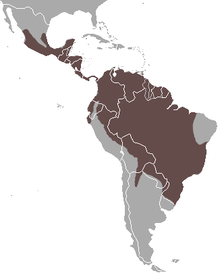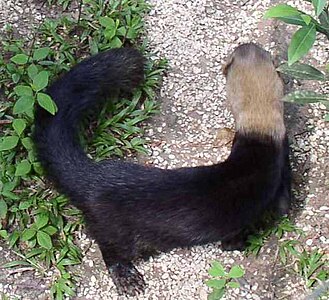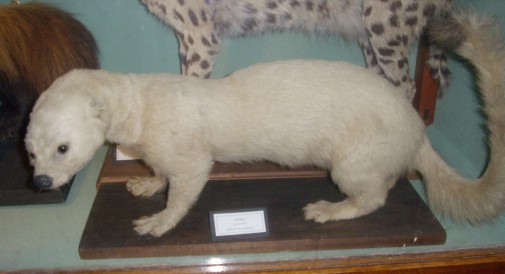
The Mustelidae are a diverse family of carnivorous mammals, including weasels, stoats, badgers, otters, martens, grisons, and wolverines. Otherwise known as mustelids, they form the largest family in the suborder Caniformia of the order Carnivora with about 66 to 70 species in nine subfamilies.

The ocelot is a medium-sized spotted wild cat that reaches 40–50 cm (15.7–19.7 in) at the shoulders and weighs between 7 and 15.5 kg on average. It is native to the southwestern United States, Mexico, Central and South America, and the Caribbean islands of Trinidad and Margarita. Carl Linnaeus scientifically described it in 1758. Two subspecies are recognized.

The kinkajou is a tropical rainforest mammal of the family Procyonidae related to olingos, coatis, raccoons, and the ringtail and cacomistle. It is the only member of the genus Potos and is also known as the "honey bear". Kinkajous are arboreal, they are not closely related to any other tree-dwelling mammal group.
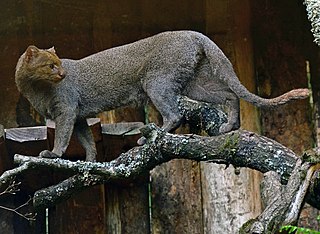
The jaguarundi is a wild cat native to the Americas. Its range extends from central Argentina in the south to northern Mexico, through Central and South America east of the Andes. The jaguarundi is a medium-sized cat of slender build. Its coloration is uniform with two color morphs, gray and red. It has an elongated body, with relatively short legs, a small, narrow head, small, round ears, a short snout, and a long tail, resembling mustelids in these respects. It is about twice as large as a domestic cat, reaching nearly 360 mm (14 in) at the shoulder, and weighs 3.5–7 kg (7.7–15.4 lb).
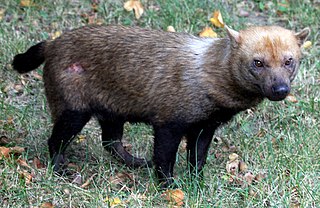
The bush dog is a canine found in Central and South America. In spite of its extensive range, it is very rare in most areas except in Suriname, Guyana and Peru; it was first described by Peter Wilhelm Lund from fossils in Brazilian caves and was believed to be extinct.

Hoarding or caching in animal behavior is the storage of food in locations hidden from the sight of both conspecifics and members of other species. Most commonly, the function of hoarding or caching is to store food in times of surplus for times when food is less plentiful. However, there is evidence that a certain amount of caching or hoarding is actually undertaken with the aim of ripening the food so stored, and this practice is thus referred to as ‘ripening caching’. The term hoarding is most typically used for rodents, whereas caching is more commonly used in reference to birds, but the behaviors in both animal groups are quite similar.

The white-winged vampire bat, a species of vampire bat, is the only member of the genus Diaemus. They are found from Mexico to northern Argentina and are present on the islands of Trinidad and Margarita.

White-fronted capuchin can refer to any of a number of species of gracile capuchin monkey which used to be considered as the single species Cebus albifrons. White-fronted capuchins are found in seven different countries in South America: Bolivia, Brazil, Colombia, Venezuela, Ecuador, Peru, and Trinidad and Tobago.

The white-headed marmoset, also known as the tufted-ear marmoset, Geoffroy's marmoset, or Geoffrey's marmoset, is a marmoset endemic to forests in eastern Brazil, where it is native to Bahia, Espírito Santo, and Minas Gerais, and introduced to Santa Catarina. It is known as the sagüi or sauim in Brazil. Its diet consists of fruits, insects, and the gum of trees. It is a host of Pachysentis lenti an acanthocephalan intestinal parasite.

The southern tamandua, also called the collared anteater or lesser anteater, is a species of anteater from South America and the island of Trinidad in the Caribbean. It is a solitary animal found in many habitats, from mature to highly disturbed secondary forests and arid savannas. It feeds on ants, termites, and bees. Its very strong foreclaws can be used to break insect nests or to defend itself.
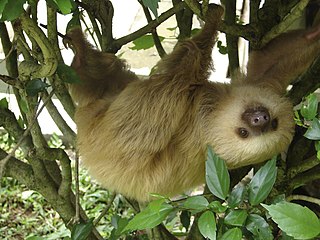
The Hoffmann's two-toed sloth, also known as the northern two-toed sloth, is a species of sloth from Central and South America. It is a solitary, largely nocturnal and arboreal animal, found in mature and secondary rainforests and deciduous forests. The common name commemorates the German naturalist Karl Hoffmann.

The greater long-nosed armadillo is a South American species of armadillo found in Colombia, Venezuela, Ecuador, Guyana, Suriname, French Guiana, Peru, Bolivia and Brazil. It is a solitary, nocturnal, terrestrial animal that feeds on arthropods and other invertebrates, usually living in the vicinity of streams and swamps.

The greater grison is a species of mustelid native to Southern Mexico, Central America, and South America.
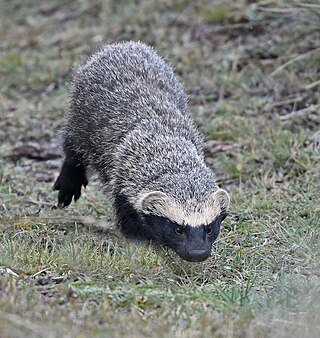
The lesser grison is a species of mustelid from South America.
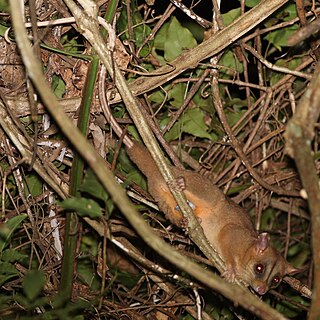
The bare-tailed woolly opossum is an opossum from South America. It was first described by Swedish zoologist Carl Linnaeus in 1758. The bare-tailed woolly opossum is characterized by a gray head, brown to gray coat, orange to gray underside and a partially naked tail. It is nocturnal and solitary; there is hardly any social interaction except between mother and juveniles and in mating pairs. The opossum constructs nests in tree cavities, and its litter size ranges from one to seven. Gestation lasts 25 days, and the juveniles exit the pouch after three months; weaning occurs a month later. The bare-tailed woolly opossum inhabits subtropical forests, rainforests, secondary forests, and plantations; its range extends from northern Venezuela to northeastern and southcentral Brazil. The IUCN classifies this opossum as least concern.

The common opossum, also called the southern or black-eared opossum or gambá, and sometimes called a possum, is a marsupial species living from the northeast of Mexico to Bolivia, including Trinidad and Tobago and the Windwards in the Caribbean, where it is called manicou. It prefers the woods, but can also live in fields and cities.
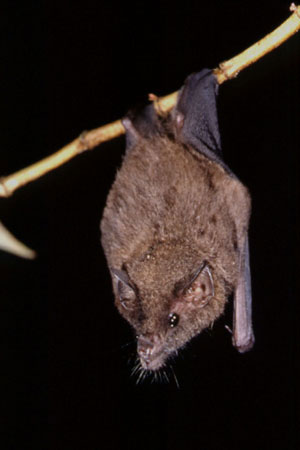
Geoffroy's tailless bat is a species of phyllostomid bat from the American tropics.

Oligacanthorhynchida is an order containing a single parasitic worm family, Oligacanthorhynchidae, that attach themselves to the intestinal wall of terrestrial vertebrates.
Prosthenorchis is a genus of parasitic worms belonging to the family Oligacanthorhynchidae. Prosthenorchis have a trunk up to 50 mm long, a proboscis that is not ornate with three barbed hooks in each of 12 rows. They have complex hook roots with large manubria, and a small discoid posterior hook base. There are up to 23 festoons. Gonopore is subterminal. The primary host are primates in South America and Felidae in Africa with cockroaches and beetles as intermediate hosts.

Pachysentis is a genus in Acanthocephala that parasitize primates and carnivorans. They are distributed across Africa, the Middle East, and the Americas. Pachysentis species attach themselves to the inner lining of the gastrointestinal tract of their hosts using their hook-covered proboscis. Their life cycle includes an egg stage found in host feces, a cystacanth (larval) stage in an intermediate host such as the Egyptian cobra, and an adult stage where cystacanths mature in the intestines of the host. This genus appears identical to the closely related Oncicola apart from a greater number of hooks on the proboscis. There are eleven species assigned to this genus, although P. septemserialis is of uncertain taxonomic status. The female worms range from 12 millimetres (0.47 in) long and 1.6 millimetres (0.063 in) wide in P. lauroi to 50 millimetres (2.0 in) long and 4 millimetres (0.16 in) wide in P. dollfusi. Virtually all of the length is the trunk, with a short proboscis. There is pronounced sexual dimorphism in this species as females are around twice the size of the males.

